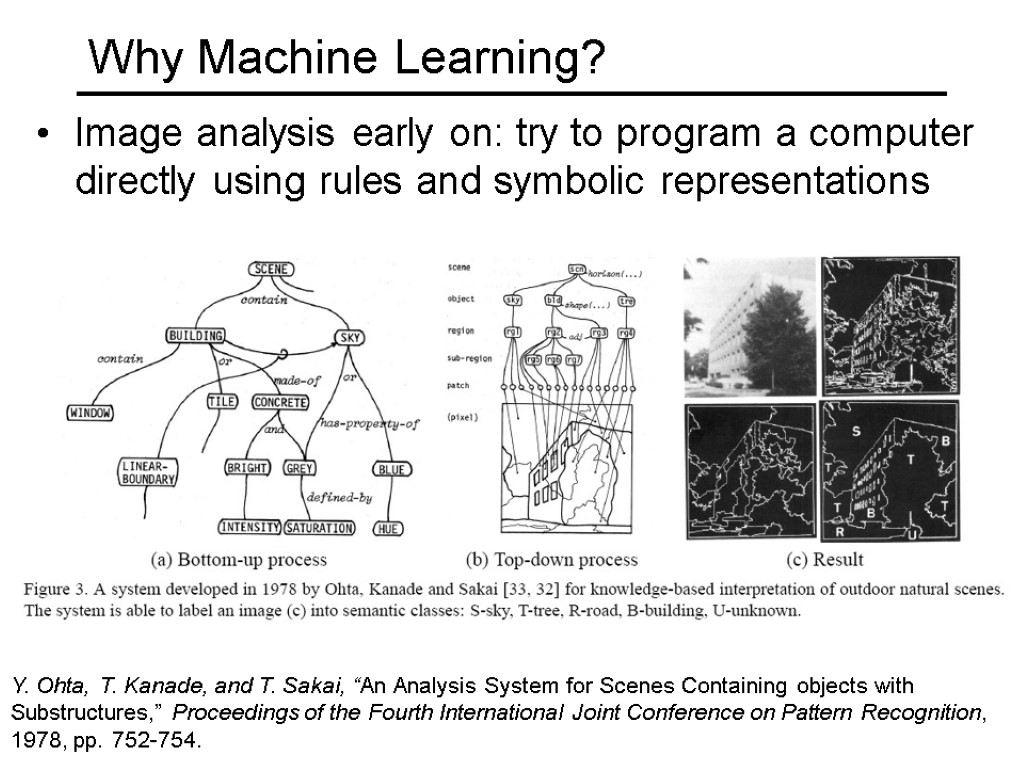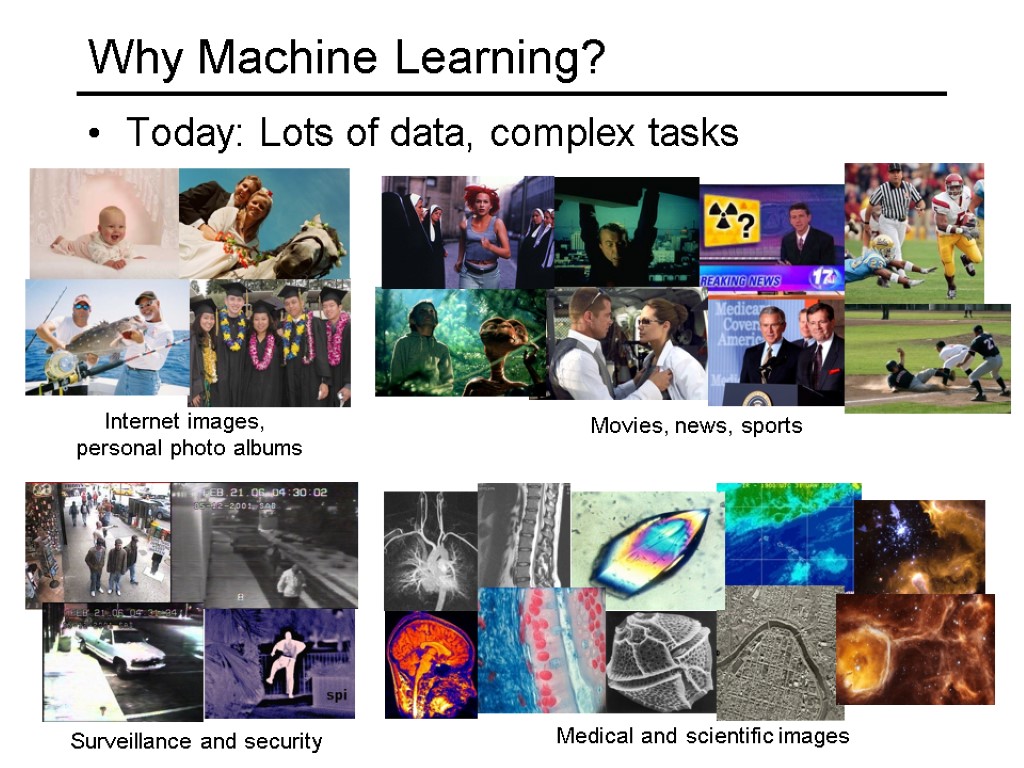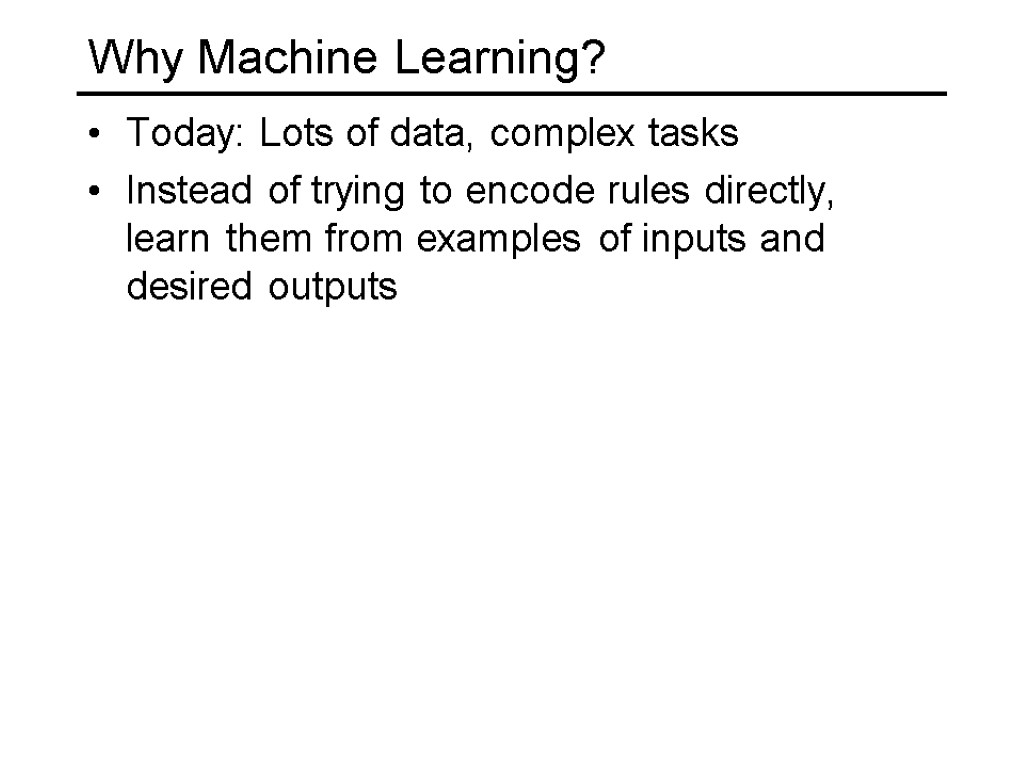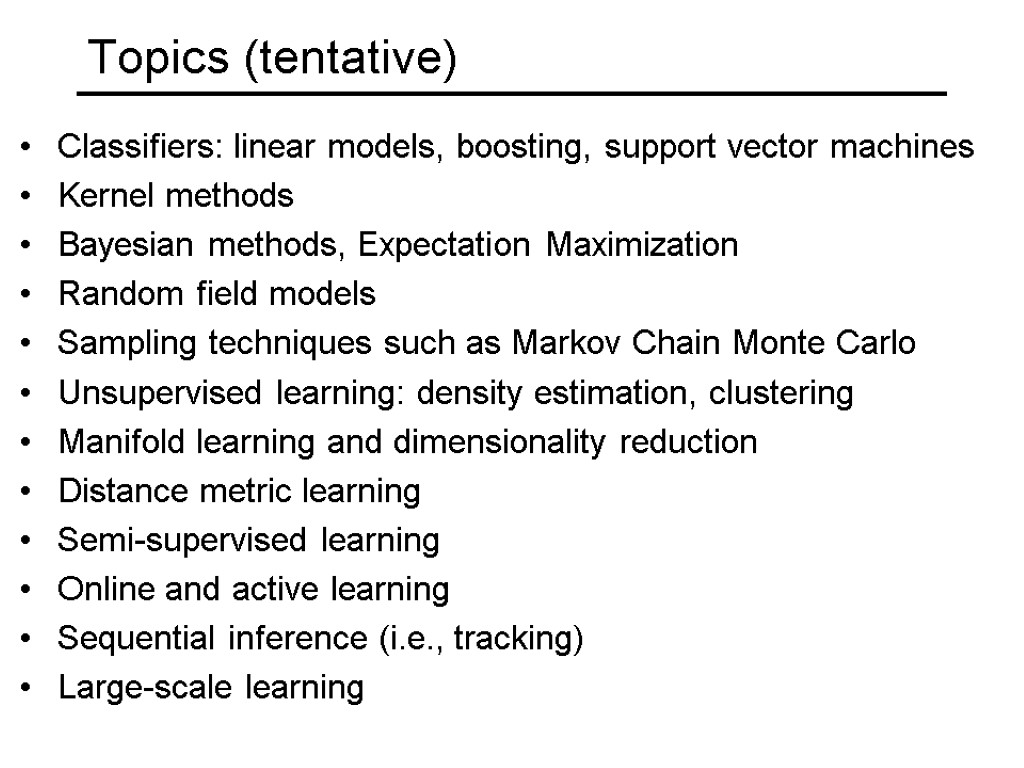COMP 875 Machine Learning Methods in Image Analysis.





















image_recognition.ppt
- Количество слайдов: 20
 COMP 875 Machine Learning Methods in Image Analysis
COMP 875 Machine Learning Methods in Image Analysis
 What the class is about “Applied” machine learning and statistical methods Applications are primarily, though not exclusively, to computer vision and medical imaging Students from other research areas are welcome Exact list of topics to be determined by you!
What the class is about “Applied” machine learning and statistical methods Applications are primarily, though not exclusively, to computer vision and medical imaging Students from other research areas are welcome Exact list of topics to be determined by you!
 Who should take this class? This is meant as an “advanced” graduate course Ideally, you should have taken COMP 665, 775, 776, or Data Mining (or similar courses elsewhere) You should be comfortable reading and understanding papers in recent conferences such as CVPR, ICCV, MICCAI, NIPS, ICML, etc. You should have some experience doing research presentations If you have questions or doubts about your background, please talk to me after this class
Who should take this class? This is meant as an “advanced” graduate course Ideally, you should have taken COMP 665, 775, 776, or Data Mining (or similar courses elsewhere) You should be comfortable reading and understanding papers in recent conferences such as CVPR, ICCV, MICCAI, NIPS, ICML, etc. You should have some experience doing research presentations If you have questions or doubts about your background, please talk to me after this class
 Why Machine Learning? Image analysis early on: simple tasks, few images L. G. Roberts, Machine Perception of Three Dimensional Solids, Ph.D. thesis, MIT Department of Electrical Engineering, 1963.
Why Machine Learning? Image analysis early on: simple tasks, few images L. G. Roberts, Machine Perception of Three Dimensional Solids, Ph.D. thesis, MIT Department of Electrical Engineering, 1963.
 Why Machine Learning? Image analysis early on: try to program a computer directly using rules and symbolic representations Y. Ohta, T. Kanade, and T. Sakai, “An Analysis System for Scenes Containing objects with Substructures,” Proceedings of the Fourth International Joint Conference on Pattern Recognition, 1978, pp. 752-754.
Why Machine Learning? Image analysis early on: try to program a computer directly using rules and symbolic representations Y. Ohta, T. Kanade, and T. Sakai, “An Analysis System for Scenes Containing objects with Substructures,” Proceedings of the Fourth International Joint Conference on Pattern Recognition, 1978, pp. 752-754.
 Today: Lots of data, complex tasks Why Machine Learning? Internet images, personal photo albums Surveillance and security Movies, news, sports Medical and scientific images
Today: Lots of data, complex tasks Why Machine Learning? Internet images, personal photo albums Surveillance and security Movies, news, sports Medical and scientific images
 Today: Lots of data, complex tasks Instead of trying to encode rules directly, learn them from examples of inputs and desired outputs Why Machine Learning?
Today: Lots of data, complex tasks Instead of trying to encode rules directly, learn them from examples of inputs and desired outputs Why Machine Learning?
 Not Just Image Analysis Speech recognition Document analysis Spam filtering Computer security Statistical debugging Bioinformatics ….
Not Just Image Analysis Speech recognition Document analysis Spam filtering Computer security Statistical debugging Bioinformatics ….
 Topics (tentative) Classifiers: linear models, boosting, support vector machines Kernel methods Bayesian methods, Expectation Maximization Random field models Sampling techniques such as Markov Chain Monte Carlo Unsupervised learning: density estimation, clustering Manifold learning and dimensionality reduction Distance metric learning Semi-supervised learning Online and active learning Sequential inference (i.e., tracking) Large-scale learning
Topics (tentative) Classifiers: linear models, boosting, support vector machines Kernel methods Bayesian methods, Expectation Maximization Random field models Sampling techniques such as Markov Chain Monte Carlo Unsupervised learning: density estimation, clustering Manifold learning and dimensionality reduction Distance metric learning Semi-supervised learning Online and active learning Sequential inference (i.e., tracking) Large-scale learning
 Class requirements Class format: lectures and student presentations Grading: Presentation: 35% Project: 35% Participation: 30%
Class requirements Class format: lectures and student presentations Grading: Presentation: 35% Project: 35% Participation: 30%
 Presentation You are “professor for a day”: you need to give a one-hour lecture that would be interesting and accessible to all the students in the class You are responsible for selecting your own topic and paper(s) Look at the list of reading materials on the class webpage Look through recent conference proceedings Pick a topic of interest based on your own research
Presentation You are “professor for a day”: you need to give a one-hour lecture that would be interesting and accessible to all the students in the class You are responsible for selecting your own topic and paper(s) Look at the list of reading materials on the class webpage Look through recent conference proceedings Pick a topic of interest based on your own research
 Presentation Guidelines Evaluation criteria Integration: utilize multiple sources Critical thinking: separate the essential from the non-essential; critique the papers you present; think of alternative applications and future research directions Interactivity: try to involve the rest of the class Structuring the presentation Will depend on your focus Broadly speaking, you may want to focus either on a particular learning topic, or a particular application
Presentation Guidelines Evaluation criteria Integration: utilize multiple sources Critical thinking: separate the essential from the non-essential; critique the papers you present; think of alternative applications and future research directions Interactivity: try to involve the rest of the class Structuring the presentation Will depend on your focus Broadly speaking, you may want to focus either on a particular learning topic, or a particular application
 Sample Presentation Outline Introduction Problem definition Problem formulation Significance Survey of methods for solving this problem Detailed presentation of one or more specific methods Discussion Pluses and minuses of different methods Compare and contrast different approaches Ideas for improvement and future research Alternative applications Alternative methods for solving the same problem Connect your topic to other topics discussed earlier in class
Sample Presentation Outline Introduction Problem definition Problem formulation Significance Survey of methods for solving this problem Detailed presentation of one or more specific methods Discussion Pluses and minuses of different methods Compare and contrast different approaches Ideas for improvement and future research Alternative applications Alternative methods for solving the same problem Connect your topic to other topics discussed earlier in class
 Presentation Timeline Reading list: due next Thursday, September 3rd Preliminary slides: due Monday the week before your scheduled presentation Practice meeting: scheduled for the week before your presentation Final slides: due by the end of the day after your presentation All of the above are part of your presentation grade (35% of total class grade) A note on slides: you must explicitly credit all sources
Presentation Timeline Reading list: due next Thursday, September 3rd Preliminary slides: due Monday the week before your scheduled presentation Practice meeting: scheduled for the week before your presentation Final slides: due by the end of the day after your presentation All of the above are part of your presentation grade (35% of total class grade) A note on slides: you must explicitly credit all sources
 Project Your project topic may be the same as your presentation topic Not required, but may make your life easier Two options: implementation or survey paper
Project Your project topic may be the same as your presentation topic Not required, but may make your life easier Two options: implementation or survey paper
 Implementation Implement one or more methods from literature Conduct a comparative evaluation Implement your own ideas or extensions of existing methods Deliverable: an “informal” final report and (possibly) a short presentation Students may collaborate, but each must submit his/her deliverables You can use existing code and/or software, provided you document all your sources and it doesn’t make your project trivial
Implementation Implement one or more methods from literature Conduct a comparative evaluation Implement your own ideas or extensions of existing methods Deliverable: an “informal” final report and (possibly) a short presentation Students may collaborate, but each must submit his/her deliverables You can use existing code and/or software, provided you document all your sources and it doesn’t make your project trivial
 Survey Paper Comprehensive tutorial, literature review A “formal” academic paper Typeset in LaTeX, 10-15 pages (single-spaced, 11pt font) Must be individual
Survey Paper Comprehensive tutorial, literature review A “formal” academic paper Typeset in LaTeX, 10-15 pages (single-spaced, 11pt font) Must be individual
 Project timeline (tentative) Project proposal: due end of September (details to follow) Progress report (for implementation) or draft paper (for survey, ~5 pages): due end of October Final report or paper: due last day of class (December 8th) All of the above are part of your project grade (35% of total class grade)
Project timeline (tentative) Project proposal: due end of September (details to follow) Progress report (for implementation) or draft paper (for survey, ~5 pages): due end of October Final report or paper: due last day of class (December 8th) All of the above are part of your project grade (35% of total class grade)
 Participation (30% of the grade) Class attendance, being on time Answer questions in review sessions at the beginning of class Be prepared Read all the material before the class and come up with ~3 questions for discussion I may call on anyone at any time Participate in discussions Send email to me and/or the class mailing group links to material that may be of interest If you never speak up in class, the best grade you can get is P+!
Participation (30% of the grade) Class attendance, being on time Answer questions in review sessions at the beginning of class Be prepared Read all the material before the class and come up with ~3 questions for discussion I may call on anyone at any time Participate in discussions Send email to me and/or the class mailing group links to material that may be of interest If you never speak up in class, the best grade you can get is P+!
 What’s next? First few weeks: lectures on the basics of machine learning Reading lists due next Thursday, September 3rd Also send any date constraints/preferences Topics may require some conflict resolution “Bonus points” for the first two students to present Class schedule finalized by the end of third week of class If you have any questions about whether you should take this class, talk to me now!
What’s next? First few weeks: lectures on the basics of machine learning Reading lists due next Thursday, September 3rd Also send any date constraints/preferences Topics may require some conflict resolution “Bonus points” for the first two students to present Class schedule finalized by the end of third week of class If you have any questions about whether you should take this class, talk to me now!

